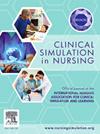将麻醉师非技术技能(ANTS)框架与基于屏幕的麻醉师护士模拟训练相结合
IF 3.4
3区 医学
Q1 NURSING
引用次数: 0
摘要
背景非技术技能(NTS)包括态势感知、团队合作、决策和领导力。术中失误和不良的患者预后与缺乏 NTS 的医疗人员有关。方法采用 Kane 的有效性框架,使用麻醉师非技术技能(NTS)框架,研究多人 SBS 与基于人体模型的模拟(MBS)作为注册麻醉师(CRNA)NTS 教育和评估平台的有效性。在 SBS 商业平台上录制了脚本情景,并在 MBS 中进行了镜像。专家组成员完成了 SBS 情景,并对表演、SBS 真实度和平台实用性进行了评分。结果专家组成员一致认为,该情景与急诊麻醉师的实践相关,ANTS 是与 SBS 相匹配的评估工具,SBS 平台适合 CE 活动,但不适合高风险评估。凯恩的外推法推论得到了支持,而评分、概括和暗示推论则需要进一步研究。结论经评估的 SBS 平台和情景可用于向注册急诊护士教授 NTS,但将 SBS 用于高风险评估需要进一步验证。本文章由计算机程序翻译,如有差异,请以英文原文为准。
Use of the Anesthetists’ Non-technical Skills (ANTS) Framework with screen-based simulation for nurse anesthetists
Background
Non-technical skills (NTS) include situational awareness, teamwork, decision making, and leadership. Intraoperative errors and adverse patient outcomes are associated with providers lacking NTS. Screen-based simulation (SBS) can be used to teach NTS.
Methods
Using Kane's validity framework, the validity of a multiplayer SBS versus manikin-based simulation (MBS) as a platform for NTS education and assessment of Certified Registered Nurse Anesthetists (CRNA) using the Anesthetist's NTS (ANTS) Framework was examined. Scripted scenarios were recorded in a commercial platform for SBS and mirrored in a MBS. Expert panelists completed the SBS scenario, and rated performances, SBS fidelity, and platform utility.
Results
Expert panelists agreed the scenario was relevant to CRNA practice, ANTS was an appropriate assessment tool with SBS, and the SBS platform was appropriate for CE activities yet inappropriate for high-stakes assessments. Kane's extrapolation inference was supported, while scoring, generalization, and implication inferences require further investigation.
Conclusions
The evaluated SBS platform and scenario could be used to teach CRNAs NTS, yet the use of SBS for high-stakes assessments requires further validation.
求助全文
通过发布文献求助,成功后即可免费获取论文全文。
去求助
来源期刊

Clinical Simulation in Nursing
NURSING-
CiteScore
5.50
自引率
15.40%
发文量
107
期刊介绍:
Clinical Simulation in Nursing is an international, peer reviewed journal published online monthly. Clinical Simulation in Nursing is the official journal of the International Nursing Association for Clinical Simulation & Learning (INACSL) and reflects its mission to advance the science of healthcare simulation.
We will review and accept articles from other health provider disciplines, if they are determined to be of interest to our readership. The journal accepts manuscripts meeting one or more of the following criteria:
Research articles and literature reviews (e.g. systematic, scoping, umbrella, integrative, etc.) about simulation
Innovative teaching/learning strategies using simulation
Articles updating guidelines, regulations, and legislative policies that impact simulation
Leadership for simulation
Simulation operations
Clinical and academic uses of simulation.
 求助内容:
求助内容: 应助结果提醒方式:
应助结果提醒方式:


